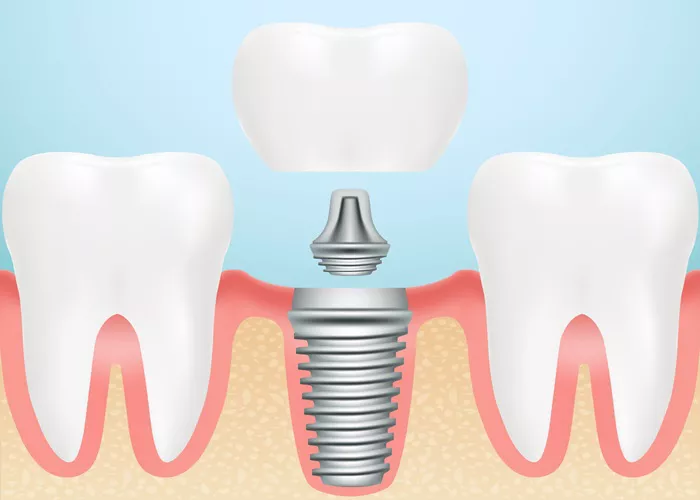Dental implants are a common solution for replacing missing teeth. They are designed to mimic the function of natural tooth roots. The jawbone plays a crucial role in the success of dental implants. Understanding whether dental implants go into the jaw is fundamental to comprehending the entire implant process.
The Anatomy of Dental Implants and the Jaw
Structure of Dental Implants
Dental implants are typically made of titanium or zirconia. They consist of three main parts: the implant fixture, the abutment, and the crown. The implant fixture is the part that is inserted into the jaw. It has a screw – like shape. This shape is designed to provide stability and initial fixation within the bone. The abutment is the connector piece that links the implant fixture in the jaw to the crown, which is the visible part of the implant that looks like a natural tooth.
The surface of the implant fixture is often treated to enhance its integration with the jawbone. For example, it may have a roughened or textured surface. This is because the better the implant can integrate with the bone, the more successful the implant will be in the long – term.
The Jawbone’s Role
The jawbone provides the foundation for dental implants. It is a living tissue that constantly remodels itself. When a tooth is missing, the jawbone in that area begins to resorb or lose density over time. Dental implants help to reverse this process by providing the necessary stimulation to the bone. The implant is inserted into the jawbone to act as an artificial tooth root. This allows the bone to grow around the implant in a process called osseointegration. Osseointegration is a key factor in the long – term success of dental implants. It involves the direct structural and functional connection between the implant and the bone at the microscopic level.
The Implant Placement Procedure
Surgical Insertion
The process of placing a dental implant into the jaw begins with a surgical procedure. First, the dentist or oral surgeon makes an incision in the gum tissue to expose the jawbone. Then, a hole is drilled into the bone at the precise location where the implant will be placed. The implant fixture is carefully inserted into this hole. The depth of insertion depends on various factors, including the length of the implant and the quality of the jawbone. For example, in a healthy, dense jawbone, a longer implant may be inserted deeper to ensure maximum stability.
During the insertion, the dentist or surgeon takes great care to ensure that the implant is placed at the correct angle. This is important for both the aesthetic and functional success of the implant. If the implant is placed at an incorrect angle, it can lead to problems such as difficulty in attaching the abutment and crown properly, or it may cause abnormal forces on the implant during chewing, which could potentially lead to implant failure.
Healing and Osseointegration
After the implant is inserted, the gum tissue is sutured back over the implant site. The healing process then begins. During this time, the body’s natural healing mechanisms take over. The bone cells start to grow and attach to the surface of the implant. This is the osseointegration process. It typically takes several months for complete osseointegration to occur.
During this period, it is important for the patient to follow the dentist’s instructions carefully. This may include taking antibiotics to prevent infection, following a soft – diet to avoid putting excessive force on the implant site, and maintaining good oral hygiene to keep the area clean.
Potential Complications and Considerations
Bone Quality and Quantity
The success of dental implants going into the jaw depends on the quality and quantity of the jawbone. If the bone is too thin or of poor quality, it may not be able to support the implant properly. In such cases, additional procedures may be required before implant placement. For example, bone grafting may be necessary to increase the bone volume. Bone grafting involves taking bone from another part of the body (such as the hip or chin) or using synthetic bone substitutes to build up the jawbone so that it can accommodate the implant.
Age can also be a factor. As people get older, the jawbone may become more brittle and less dense. However, this does not necessarily mean that dental implants are not an option. With proper evaluation and treatment planning, dental implants can still be successful in older patients.
Infection and Implant Failure
One of the potential complications of dental implant placement is infection. If bacteria enter the implant site during or after the surgery, it can lead to an infection. This can interfere with the osseointegration process and may ultimately result in implant failure. To prevent infection, strict sterile techniques are used during the implant surgery, and patients are advised to keep the area clean and follow any post – operative instructions carefully.
Another cause of implant failure can be excessive force on the implant. If a patient bites too hard or engages in habits such as grinding their teeth (bruxism), it can put too much stress on the implant. This can cause the implant to loosen or break over time.
Conclusion
In conclusion, dental implants do go into the jaw. The process is a carefully planned and executed surgical procedure that involves inserting an implant fixture into the jawbone to act as an artificial tooth root. The success of this process depends on various factors, including the quality of the jawbone, the correct placement of the implant, and proper post – operative care. While there are potential complications, with appropriate medical and patient – centered care, dental implants can be a highly effective solution for replacing missing teeth.
Related topics:

